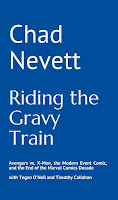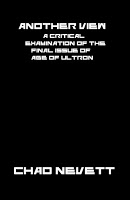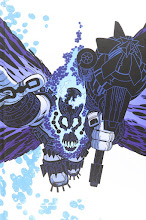 Okay, a little bit later than I expected... especially since this has been sitting partly-written here for over a week... Ah well...
Okay, a little bit later than I expected... especially since this has been sitting partly-written here for over a week... Ah well...Final Crisis has finished and it seems like the right time to re-explore The Death of the New Gods, which... well, didn't really work with Final Crisis at all, did it? But that's only a problem if you care about "Official DCU Continuity," which I don't. No, I can separate all of my comics into their own little worlds. Like Final Crisis actually exists in the Grant Morrison DCU that began with Animal Man went right on through his early Batman work, Doom Patrol, JLA, Seven Soldiers, Batman and, then, Final Crisis. While The Death of the New Gods really just exists, for me, alongside Cosmic Odyssey and not much else. See how easy that is? It leads to far less headaches and a lot more enjoyment. Now, of course, Morrison wrote Final Crisis in a way that explains why it doesn't sync up with Countdown and The Death of the New Gods, but who cares? I sure don't.
The Death of the New Gods features Jim Starlin writing and drawing a murder mystery where New Gods are found dead all over the universe, gaping hole in their chest, but that wound isn't the cause of death. As the story progresses, more New Gods die, suspects emerge and are discarded (including the Infinity Man, Darkseid, and Orion), a second Source Wall is discovered in front of the original with the newly killed New Gods' likenesses on it, Metron discovers the culprit and observes what happens, and, ultimately, Darkseid is the last one left standing.
While I was disappointed in Cosmic Odyssey for its lack of exploration of the idea of these characters as the New Gods, Starlin uses this series to really explore that idea by having the force that's killing them revealed as the Source. That's right, the New Gods' god is killing them... I love that idea. Starlin really plays with it in both a religious and a metafictional manner.
Metron is the first to discover the identity of the killer (although, we're told later that Darkseid figured it out before that, but kept the knowledge hidden so he could prepare to fight back and save himself) and, when he does, the Source says to him, "YOU WERE ALWAYS MY FAVORITE OF THE NEW GODS," a position that Starlin possibly shares? He devotes quite a bit of space to Metron, starting in the first issue with some inventive art. Metron, I guess, uses drugs to "sleep" (aka hallucinate) and, when he comes out of his hallucination, Starlin repeats a panel of Metron looking shocked, but then has it shatter, revealing the pipe behind it. One of those great Starlin touches that you don't see a lot of artists trying these days.
Getting back on track, the discussion that ensues between Metron and the Source is thinly disguised as Metron talking to Jim Starlin (or DC editorial) as the Source maintains that mistakes were made and it's time to begin anew. Much of the conversation is more plot-oriented, but Starlin can't resist a few subtle bits that tells us what we already know: there are plans that require the New Gods to die. The Fifth World reboot, whatever it is, is coming and that means no more Fourth World. The Source doesn't enjoy doing it, but it has to, so... The real reason is that the Anti-Life Equation is part of the Source and it needs to reunite with it, and needs the power source of the New Gods' souls to do so.
Elsewhere, the New Gods are trying to solve the mystery of who is killing them off. Mister Miracle undergoes a transformation after the death of his wife, Big Barda. He changes the colours of his costume from red, yellow and green to black, blue and violet. He also uses his apparent mastery of the Anti-Life Equation extensively, seemingly corrupted by the power. The connection between Mister Miracle and the Anti-Life Equation is one of the most interesting pieces of subtext in this book (and I'm guessing not a creation of Jim Starlin) since it creats an implied connection between Mister Miracle and Darkseid. The focus of Darkseid's father/son relationship is always on Orion, but Scott Free is the adopted son that Darkseid got in return for Orion. You would think there would be some parental issues there and it's really ironic that while Darkseid always obsesses over Orion killing him, it's the son he never thought about, the one he never considered that has mastered that which he aspires to. When Darkseid and Orion clash at the end of the series, it's after Mister Miracle has already bested Darkseid using the Anti-Life Equation in an earlier issue. Darkseid is overshadowed by both of his sons.
Scott Free's struggle throughout the series is interesting and more in line with Starlin's pet themes. He is a man torn between good and evil, psychologically fractured and having a nervous breakdown. He attacks Orion and Superman at one point. He is all-powerful and that power corrupts. When he uses the Anti-Life Equation, he becomes a being of energy and looks nothing like himself. He's a familiar character in the Starlin tradition. In the end, he's the one most betrayed by the Source. He can't contemplate that their god would do this to them and asks for death. As does Metron.
The final confrontation between Darkseid and the Source has Darkseid using the Source's own stockpile of power against it, tapping into that second wall in front of the Wall. He also uses a weird elixir to power himself further. That is, until Orion's soul is called to fight him--as it wasn't collected like the others. Darkseid escapes, presumably to die in the pages of Countdown and New Genesis and Apokolips crash into one another.
The use of Superman is interesting as he isn't a New God. He's the witness to their destruction, the sole survivor of the final conflict that results in New Genesis and Apokolips crashing into one another and merging (strangely, a more fitting end to the New Gods' conflict than the one Morrison provided--at least when looking at his repeated use of symmetries and balance... the merging of good and evil... eliminating the duality). Superman also seems to represent the DC fan, the bystander outraged that this is all happening for no reason. The final issue's cover has Superman on his knees in a rage, floathing in front of the heads/figures of the deceased New Gods, screaming, "NO! / IT CAN'T END LIKE THIS!" His feelings are the feelings of fans wondering why this is happening, what purpose it serves... In that issue he's more thoughtful than angry, but the message is still the same: why did this happen? He consoles himself with the knowledge that this may bring about the Fifth World and that, finally, he remembers the characters and "IT WILL HAVE TO BE ENOUGH THAT I HAVE KNOWN GODS."
That's all that readers have left, really: the comics they own and the time spent reading them. Will these characters return? Maybe. But, if not, their adventures still exist on the page. Isn't that enough?






